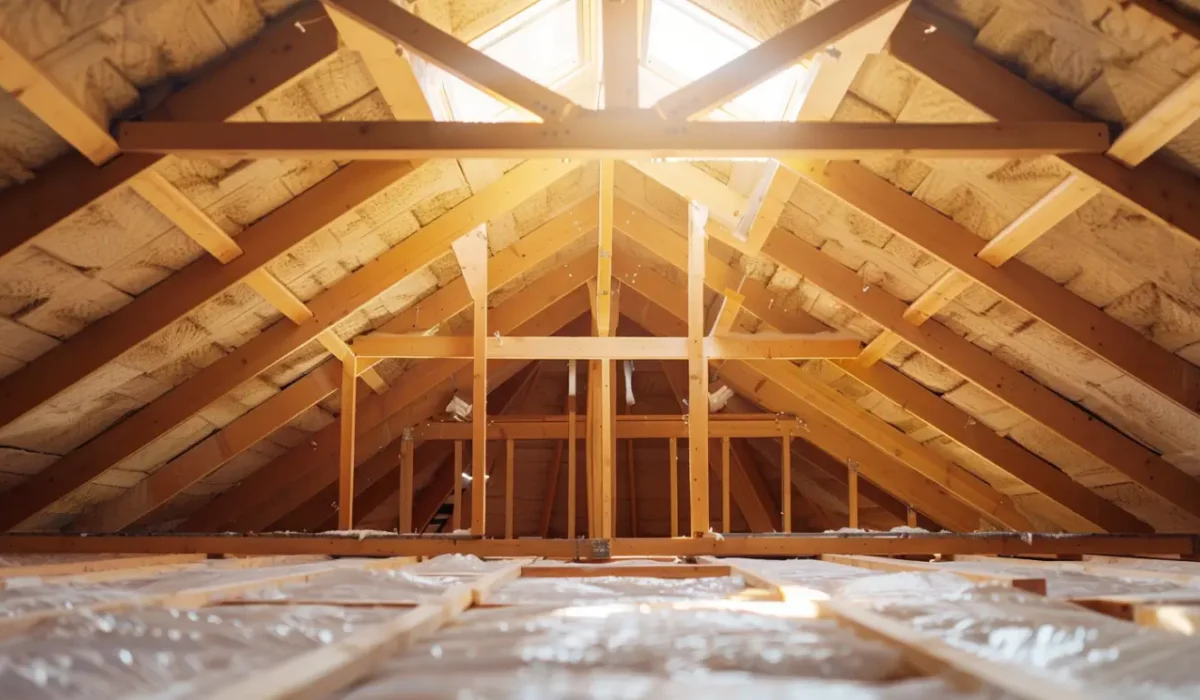Your roof gives you much more than protection from weather. It is a system that works with many parts, and roof insulation is one important part. Many people do not think about how roof insulation affects energy efficiency, comfort, and the strength of their home. At KangaRoof, we pride ourselves on being a trusted roofing company serving Coppell, TX since 1992. Our experienced team is dedicated to providing quality roofing solutions tailored to meet the unique needs of both residential and commercial clients. We understand the crucial role that the right insulation and roofing materials play in enhancing your home’s safety and overall quality of life. With KangaRoof, you can expect expert guidance and exceptional service every step of the way.
Understanding Roof System Insulation
A roof insulation system plays a crucial role in maintaining the structural integrity of your roof. It involves various insulation materials, such as fiberglass, foam, and rigid board, strategically placed in the attic space or roof cavity. Proper installation ensures that heat transfer is minimized, promoting energy efficiency by controlling air leakage and thermal bridging. The effectiveness of the insulation directly impacts indoor temperatures and comfort levels, ultimately reducing energy consumption and cost for heating and cooling systems throughout the year.
Contact Us

What Is Roof Insulation and Where Is It Installed?
Roof insulation refers to materials installed between rafters or on top of the roof deck to minimize heat transfer. It is typically placed in attics, ceilings, and vaulted spaces, ensuring energy efficiency and comfort while protecting against temperature fluctuations throughout the year.
Key Components of a Well-Insulated Roof System
A well-insulated roof system boasts several key components that enhance the overall energy efficiency and structural integrity of your home. The insulation materials utilized, whether fiberglass insulation, spray foam, or rigid board, significantly impact thermal performance. Additionally, proper installation is vital to minimize air leakage and heat transfer. Adequate attic ventilation must also be considered to prevent condensation buildup and excessive heat. Incorporating these elements ensures a comfortable living space, supporting the longevity and health of your roof while reducing energy costs.

How Insulation Under Your Roof Affects Energy Efficiency
Effective insulation under your roof optimizes energy consumption by minimizing heat transfer, thus significantly reducing heating and cooling costs year-round. With a proper layer of insulation, warm air is retained during colder months, while excessive heat is kept at bay in the summer. This consistency in indoor temperatures enhances overall comfort and reduces the workload on cooling systems, leading to cost savings on energy bills. Proper installation of materials like spray foam or fiberglass insulation further contributes to the structural integrity and energy efficacy of your home.
Reducing Heating and Cooling Costs Year-Round
Effective insulation plays a crucial role in minimizing heating and cooling costs throughout the year. By providing a robust layer of insulation within the roof system, the transfer of heat is significantly reduced, leading to a more stable indoor environment. This reduction in heat loss during winter and heat gain in summer directly impacts your home’s energy efficiency, lowering energy bills and contributing to a smaller carbon footprint. Properly installed insulation helps maintain comfortable living spaces, lessening the demand on heating and cooling systems.
Improving Indoor Comfort in Seasons
Maintaining a comfortable living space in Texas necessitates effective roof insulation, especially during the sweltering summers and cooler winters. Proper insulation minimizes heat transfer, ensuring that indoor temperatures remain stable and manageable. By reducing air leakage and preventing thermal bridging, the effectiveness of the isolation enhances overall energy efficiency, resulting in lower energy bills. Additionally, adequate isolation plays a crucial role in moisture control, limiting condensation buildup that can lead to structural damage, thus safeguarding the health of your roof and ensuring year-round comfort.

The Role of Insulation in Roof Health and Longevity
Proper insulation is crucial for maintaining the structural integrity of your roof and enhancing its lifespan. Adequate isolation helps control heat transfer, reducing the formation of ice dams and protecting roofing materials from structural damage. Additionally, effective moisture control minimizes the risk of mold growth, which can deteriorate the health of your roof. By ensuring proper installation and utilizing high-quality isolation materials, homeowners can significantly extend the life of their roofs while enjoying lower energy costs and a more comfortable living space.
Preventing Moisture Damage and Mold Growth
A well-insulated system plays a crucial role in moisture control, preventing condensation buildup that can lead to structural damage and mold growth. Utilizing the best type of insulation, such as spray foam or rigid foam insulation, creates a tight seal that minimizes air leakage and heat loss. This effective barrier protects the underside of the roof from excessive moisture and retains indoor temperatures, ensuring a healthier living environment. Proper installation is essential to safeguarding the integrity and lifespan of your roof against future moisture issues.
Extending the Lifespan of Roofing Materials
Effective isolation is crucial for prolonging the lifespan of roofing materials. A well-designed layer of isolation minimizes heat transfer, reducing thermal bridging that often leads to structural damage. Proper installation not only controls temperature fluctuations but also aids in moisture control, significantly lowering the risk of condensation buildup. By preventing ice dams and maintaining optimal indoor temperatures, homeowners can protect their roofs from excessive wear and ultimately achieve cost savings on replacements, ensuring a healthier structure over time.

Types of Insulation Best Suited
Selecting the right type of insulation is vital for maximizing the energy efficiency of your system. Fiberglass isolation is popular due to its effective thermal performance and cost-effectiveness, while spray foam isolation offers superior air sealing and moisture control. Rigid foam isolation stands out for its durability and higher isolation value per inch. Understanding the specific needs of your home and local weather conditions can guide you towards the best isolation type, ensuring optimal indoor temperatures and a comfortable living space.
Fiberglass, Spray Foam, and Rigid Board Comparisons
Various types of insulation offer distinct benefits for optimizing your roof system. Fiberglass insulation, renowned for its cost-effectiveness and ease of installation, provides effective thermal resistance but can struggle with moisture control. Alternatively, spray foam isolation excels at air sealing and moisture management, significantly enhancing the home’s energy efficiency. Rigid board isolation presents a robust solution, effectively minimizing heat transfer and condensation buildup in colder climates. Each option influences energy consumption and indoor comfort, making careful selection essential for the structural integrity of your roof.
Choosing the Right Insulation for Local Weather and Roof Design
Selecting suitable insulation requires understanding the interplay between local climate and roof design specifics. In warmer regions, materials like spray foam insulation provide superior thermal resistance and can significantly reduce heat transfer, ensuring a comfortable living space. Conversely, colder climates benefit from fiberglass isolation, designed to mitigate heat loss while preventing issues like condensation buildup and the formation of ice dams. Consulting with a roofing company can help identify the best type of isolation tailored to your home’s energy efficiency needs and structural integrity.
What’s Next
Effective roof insulation is essential for enhancing your home’s energy efficiency and protecting its structural integrity. By selecting the best type of insulation and ensuring proper installation, homeowners can significantly reduce energy consumption, manage indoor temperatures, and create a comfortable living space. This investment not only leads to cost savings on heating and cooling bills but also contributes to a smaller carbon footprint. Prioritizing insulation under your roof system ultimately ensures the longevity and health of your roofing materials.
Frequently Asked Questions
How often should roof insulation be inspected or replaced?
Regular inspections of roof insulation should occur every 1 to 3 years, especially in regions with extreme weather. Replacement may be necessary if significant wear, moisture damage, or mold is detected. Addressing insulation issues promptly ensures optimal energy efficiency and prolongs the lifespan of your roof system.
What are the benefits of insulating your roof?
Insulating your roof enhances energy efficiency, significantly reducing heating and cooling costs. Additionally, it increases indoor comfort during extreme Texas weather while preventing moisture damage and mold growth, ultimately extending the lifespan of your roofing materials for long-term savings.
Read our blog: Roofing Prep Tips Before Major Home Renovation Projects
